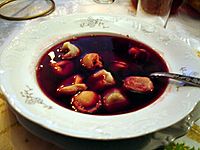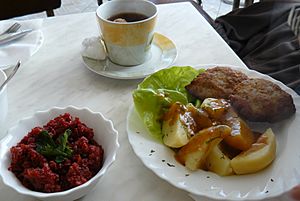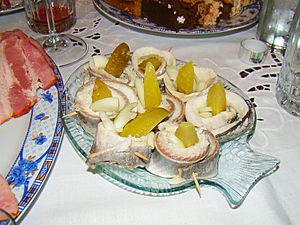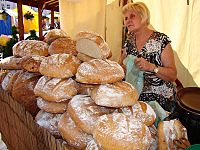Polish cuisine facts for kids
Polish cuisine (in Polish: kuchnia polska) is a special way of cooking and making food that comes from Poland. Over many years, Polish food has become very diverse because of Poland's long history. It shares many similarities with food from other nearby countries. When Polish-style cooking is used in other places, it's often called à la polonaise, which means 'Polish-style' in French.
Polish food often has a lot of meat, especially pork, chicken, and game (like wild animals). It also uses many vegetables, spices, mushrooms, and herbs. You'll find different kinds of noodles, cereals, and grains too. Generally, Polish food is hearty and uses a lot of butter, cream, eggs, and many seasonings. Traditional dishes can take a long time to prepare. Many Poles enjoy taking their time to serve and eat special meals, like Christmas Eve supper (Wigilia) on December 24th or Easter breakfast. These meals can take days to get ready!
Some famous Polish national dishes include bigos (a stew), pierogi (dumplings), kiełbasa (sausage), pork loin kotlet schabowy (a breaded cutlet), gołąbki (cabbage rolls), and zrazy (meat rolls). Popular soups are sour cucumber soup (zupa ogórkowa), mushroom soup (zupa grzybowa), tomato soup (zupa pomidorowa), rosół (meat broth), żurek (sour rye soup), flaki (tripe soup), and red beetroot barszcz.
A traditional Polish dinner usually has three parts. It starts with a soup, like the popular rosół broth or tomato soup. In restaurants, after the soup, you might have an appetizer. This could be herring (made with cream, oil, or jelly) or other cured meats and vegetable salads. The main course usually has meat, like roast meat, a breaded pork cutlet, or chicken. It often comes with a salad called surówka, which is like coleslaw. This salad is made from shredded root vegetables with lemon and sugar, or sauerkraut or mizeria salad. Side dishes are usually boiled potatoes, kasza (groats), or sometimes rice. Meals often end with a dessert like makowiec (a poppy seed pastry), napoleonka (cream pie), or sernik (cheesecake).
When Polish cooking styles are used in other countries, it's called à la polonaise. For example, in France, this means using butter instead of cooking oil. It also means frying vegetables with buttered breadcrumbs, minced parsley, and boiled eggs. Adding horseradish, lemon juice, or sour cream to sauces like Velouté is also part of this style.
History of Polish Food
Food in the Middle Ages
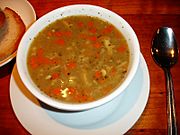
In the Middle Ages, Polish food was made from farm products and grains like millet, rye, and wheat. People also ate meat from wild and farm animals, fruits, forest berries, and honey. Herbs and local spices were common. Polish food was known for using a lot of salt from Wieliczka and always having groats (kasza). Meals were very filling, and people often drank beer or mead.
During this time, Polish food was heavy and spicy. Meat (from both wild animals and beef) and grains were the main ingredients. At first, proso millet was common, but later other grains were used a lot. Most common people didn't eat bread. Instead, they ate grains as kasza or different types of flatbread. Some of these flatbreads, like kołacz, are still traditional today. Besides grains, people ate many beans, mostly broad beans and peas. Since Poland had many forests, mushrooms, forest berries, nuts, and wild honey were also widely used. Rich Polish nobles even ate honey-braised bear paws with horseradish salad, smoked bear tongue, and bear bacon. (Today, bears are protected in Poland.)
Because Poland traded a lot with Turkey and countries in the Caucasus, spices like black pepper and nutmeg were cheaper there than in the rest of Europe. This made spicy sauces very popular. Two main sauces, jucha czerwona (red blood) and jucha szara (gray blood), were used until at least the 18th century.
Everyday drinks included milk, whey, buttermilk, and different herb infusions. The most popular alcoholic drinks were beer and mead. However, in the 16th century, richer people started to import Hungarian and Silesian wines. Mead was so common that in the 13th century, Prince Leszek I the White told the Pope that Polish knights couldn't join a crusade because there was no mead in the Holy Land. Also, vodka became popular, perhaps first among common people. There is proof that vodka started in Poland. The word "vodka" was first written down in 1405 in Akta Grodzkie, which were court documents from the Palatinate of Sandomierz in Poland. Back then, "wódka" meant chemical mixtures like medicines or cosmetic cleaners. The popular drink was called gorzałka.
The Renaissance and New Foods
When the Italian queen Bona Sforza (who married Sigismund I of Poland) came to Poland after 1518, many Italian cooks came with her. Even though vegetables were already a part of Polish food, this time brought more use of vegetables like lettuce, leeks, celeriac, and cabbage. Even today, some of these vegetables are called włoszczyzna in Polish, a word that comes from Włochy, the Polish name for Italy. During this time, spices from Western Asian trade routes were common for those who could afford them. Fancy dishes could be very spicy. However, the idea that Queen Bona was the first to bring vegetables to Poland is not true. While her cooks might have made vegetables more popular in royal Polish cooking, records show that King Jogaila (who died in 1434, long before her reign) already enjoyed many vegetables. These included lettuce, beets, cabbage, turnip, carrots, peas, and cauliflower.

Polish-style pickled cucumber (ogórek kiszony) is a type of pickle from northern Central Europe. It has been sent all over the world and is found in many countries' foods. It's usually kept in wooden barrels. A cucumber pickled for only a few days tastes different (less sour) than one pickled for longer. This is called ogórek małosolny, meaning "lightly salted cucumber." Another popular pickled cucumber in Poland is ogórek konserwowy (preserved cucumber). This one is preserved with vinegar instead of just pickling, which gives it a sweet and sour taste.
It's clear that Queen Bona's court ate Italian-style food because she only hired Italian cooks. Some of them were first hired for parties, but soon they were serving typical Italian dishes every day. Court records show that Queen Bona brought in many fruits from southern Europe, America, and Western Asia. These included oranges, lemons, pomegranates, olives, figs, and tomatoes. She also imported vegetables like potatoes and corn, nuts like chestnuts, raisins, and almonds (including marzipan). Grains like rice, cane sugar, and Italian olive oil were also imported. The court also brought in herbs and spices like black pepper, fennel, saffron, ginger, nutmeg, cloves, and cinnamon.
The Polish–Lithuanian Commonwealth and Beyond
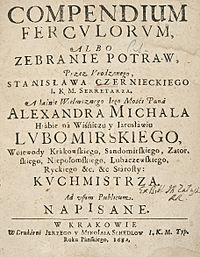
Before Poland was divided by other empires, it was one of the biggest countries in the world. It had many regions, each with its own special food traditions. Two Polish kings, Władysław IV and John II Casimir, married the same French Duchess, Marie Louise Gonzaga. She came to Warsaw in 1646 and brought many French people with her, including cooks.
Records show that her guests ate wild game and many kinds of birds. They also ate fish and shellfish like loach, different trout, grayling, fresh and smoked salmon, flounder, salted herring, lampreys in vinegar, oysters, and snails. French and Italian wines were served, along with mead and local beers. The dishes were made only using French recipes. The royal court's new ideas greatly influenced other noble homes across Poland. French food became popular, and many families hired French cooks. In the mid-18th century, French champagne also appeared on Polish tables.
Some of the most important food styles in the Polish–Lithuanian Commonwealth were Lithuanian, Jewish, German, and Hungarian cuisine. Armenian cuisine also came to Poland before the 17th century with many settlers, especially in the southeastern part of the country. Special dishes from Western Asia came to the royal court as gifts from sultans. The biggest influences were seen in cities like Lwów, Kraków, Kamieniec Podolski, and Zamość because many Armenians lived there. Also, because of close contact with the Ottoman Empire, coffee (kawa) and boza became popular.
Later, as Poland faced problems and there was a crisis in grain production, potatoes started to replace grains as a main food. The oldest Polish cookbook that still exists is Compendium ferculorum, albo Zebranie potraw ("Collection of Dishes") by Stanisław Czerniecki, published in Kraków in 1682. When Poland was divided, its food was heavily influenced by the foods of the surrounding empires. This included Russian and German foods, and also the cooking traditions of most nations in the Austro-Hungarian empire. The 19th century also saw many Polish cookbooks written by authors like Jan Szyttler and Lucyna Ćwierczakiewiczowa.
Polish Food After World War II
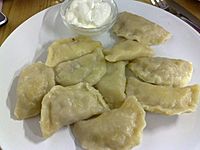
After World War II, Poland became a communist country. Some restaurants were taken over by the government. The communists planned to have "bufet" (lunch rooms) for workers and "milk bars" for everyone else. Most restaurants that survived the 1940s and 1950s were owned by the state. Workplace lunch rooms mostly offered cheap meals. These included all kinds of soups, meatballs, pork chops, and common foods like potato pancakes (placki ziemniaczane), apple pancakes (placki z jablkami), potato dumplings (kopytka), sweet farmer's cheese dumplings (leniwe), and pierogi. A typical second course was a meat cutlet with potatoes or buckwheat and surówka (raw, shredded vegetables). The popular Polish kotlet schabowy is a breaded cutlet similar to the Austrian Wiener schnitzel.
Over time, a shortage economy meant that meat, coffee, tea, and other everyday ingredients became hard to find. Many products like chocolate, sugar, and meat were rationed. This meant people could only buy a certain amount, depending on their job or health needs. Physical workers and pregnant women usually got more food. Imports were limited, so most food came from inside Poland. Food became very similar everywhere. Being a chef was no longer a special job, and for decades, Poland was cut off from most foreign foods. Tropical fruits (like citrus, banana, pineapple) were only available during holidays. Local fruits and vegetables were mostly seasonal. For most of the year, Poles ate winter fruits and vegetables like apples, plums, currants, onions, potatoes, cabbage, and root vegetables. Other foreign foods were very expensive at markets.
This situation led to traditional Polish food being replaced by dishes made from whatever was available. One popular dish in public restaurants was "kotlet mielony" (meatball). This was a type of hamburger often served with beet puree and fresh carrots. Traditional recipes were mostly kept alive during the Wigilia feast on Christmas Eve. Many families tried to prepare 12 traditional dishes for this special meal.
A popular fish dish was, and still is, the paprikash (paprykarz szczeciński) from the city of Szczecin. It's often used as a spread on sandwiches.
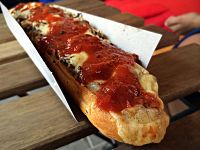
Modern Polish Cuisine
When communism ended in Poland in 1989, many new restaurants opened. Basic foods became easy to find again. This led to a slow return of rich, traditional Polish cuisine, both in homes and restaurants. At the same time, restaurants and supermarkets started offering ingredients from other parts of the world. Some new foods that became common in Poland were cucurbits, zucchini, and all kinds of fish. During communist times, these were mostly fresh only near the sea.
In recent years, a slow food movement has grown. Many TV shows about different foods, including traditional Polish food, have become popular. In 2011, a cookbook (written in English) was published in London. It combined childhood memories from the Gierek era with traditional Polish recipes.
American fast food, like McDonald's, KFC, and Pizza Hut, is becoming less popular in Poland. Polish people often prefer their own food, including Polish fast food. Meanwhile, Doner kebabs are gaining popularity. Still, in most of Poland, you can find traditional and very popular Polish street food like the zapiekanka. This is a pizza-like baguette with cheese, mushrooms, onion, sometimes meat, and ketchup. There are also many small, quick-service restaurants that usually serve kebabs, hamburgers, hot dogs, and Polish kiełbasa sausage. In the southern mountains, oscypek served with cranberry jam is a popular street food.
Special Holiday Meals
Christmas Dishes
The traditional Wigilia (Christmas Eve supper) is meatless, except for fish. It usually starts with barszcz (borscht) with uszka (small dumplings). This is a classic Polish Christmas Eve starter. Then comes fried carp, carp fillet, or cod with apple and leeks salad, or carp in aspic. Carp is a main part of the Christmas Eve meal across Poland. Other popular dishes for the next day include pickled matjas herring, rollmops, pierogi with sauerkraut and forest mushrooms, fish soup, kiełbasa, hams, bigos (cabbage and meat stew), and vegetable salads. Popular desserts are gingerbread, cheesecake, various fruits like oranges, poppy seed cake makowiec (or makówki in Silesia), fruit kompot, kluski with poppyseed, and gingerbread. Regional dishes include żurek, siemieniotka (in Silesia), and kołduny (stuffed dumplings with mushrooms or meat from the eastern regions).
Fat Thursday Sweets
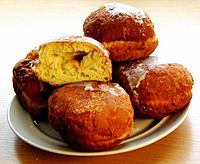
Tłusty Czwartek or "Fat Thursday" is a Polish tradition on the last Thursday before Lent. It's like Pancake Day in other countries. Traditionally, it's a day to enjoy sweets and cakes before the forty days of fasting that Catholics observe until Easter Day.
The most popular sweets on Fat Thursday are pączki (Polish doughnuts) and faworki (sometimes called "chrust"), which are like French beignets. Traditional Polish doughnuts are filled with rose petal jam, plum jam, or apple. They are covered with icing and orange peel or sprinkled with icing sugar. Fat Thursday used to mark the start of a "Fat Week." During this time, Polish ancestors ate many rich dishes with smalec (lard), bacon, and all kinds of meat.
The first doughnuts, popular until the 16th century, were made from the same dough as bread. They were filled with pork and fried in smalec. Only later did they become sweet pastries.
Easter Breakfast Feast
A typical Easter breakfast often has cold meats with horseradish sauce and beet salads. There are also breads, bigos, żurek, kiełbasa, smoked salmon or herring, and marinated vegetable salads. A special Easter salad is made with chopped boiled eggs, green peas, ćwikła (beetroot with horseradish), carrot, apple, potato, parsley, and mayonnaise. People drink coffee and tea and eat cakes like chocolate cake, makowiec, mazurek, and sernik.
Regional Dishes and Soups
Poland has many unique regional foods with different ways of cooking and ingredients. For example, there are special dishes in Galicia, Kresy, Podlachia, Masovia (including Warsaw), Masuria, Pomerania, Silesia, Lesser Poland, the Tatra mountains, and Greater Poland.
All soups usually start with fresh chicken, beef, or pork ribs stock, along with root vegetables. If you're vegetarian, the stock is made without meat. The meat from the stock can be eaten with the soup, used in another dish, or eaten alone with bread. It's common to have two dishes for dinner: one is always soup, and the other is potatoes, rice, groats, or pasta with meat, stews, or sweet dishes. Cream or purée soups are not traditional in Poland but are made because of influences from other countries. Soups are often made lighter by adding a splash of sour or double cream.
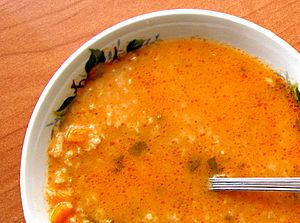
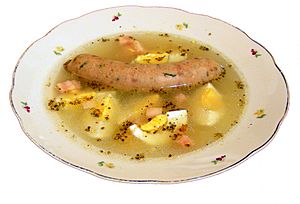
- Zupa pomidorowa - Thin tomato soup made with tomato purée, root vegetables, and stock. It's usually served with pasta or rice, and sour cream is often added.
- Kartoflanka - Potato soup with root vegetables.
- Czarnina - Duck soup or duck blood soup. The duck blood gives the soup a dark, almost black color. Recipes vary, but sweet and sour ingredients like vinegar, sugar, fruit juice, or fruit (e.g., prunes, pears) are often added. It's usually served with duck meat and Kluski-style noodles. It's not eaten as commonly today.
- Chłodnik litewski - Cold beet leaves' soup made with soured milk or sour cream, young beet leaves, cucumbers, and chopped fresh dill. Sometimes chives and radishes are added.
- Botwinka - Beet leaves soup with potatoes and root vegetables, served hot.
- Barszcz czerwony - Red borscht is a clear beetroot soup made from stock, beetroots, and beetroot sourdough. It's often served with uszka, krokiet (made from naleśniki), pasztecik, pierogi, and sometimes with white beans, red kidney beans, or mashed potatoes. It's a very important dish for Christmas Eve.
- Zupa buraczkowa - Beetroot soup with grated beetroots, potato cubes, and root vegetables. Sometimes it's called red borscht, like the Christmas Eve one, but it doesn't have beetroot sourdough. It's slightly sweet but not sour.
- Barszcz ukraiński - Ukrainian borscht is a beetroot soup with sliced white cabbage, white or red kidney beans, and diced tomatoes or tomato purée. (In Ukraine, beans are not used in this dish.)
- Zupa szczawiowa - Sorrel soup made with sorrel leaves and rice, served with a hard-boiled egg.
- Flaki or Flaczki - Beef or pork tripe stew with marjoram and spices. Vegetarians make this soup with oyster mushrooms.
- Rosół - Clear chicken soup served with noodles, usually short vermicelli. The stock is made from root vegetables and a whole chicken, beef, or both.
- Zupa grzybowa/pieczarkowa - Mushroom soup made from white or wild mushrooms with potatoes or pasta. For Christmas Eve, it's usually served with łazanki pasta or uszka.
- Zupa ogórkowa - Sour cucumber soup made from sour, salted cucumbers.
- Żur - Żur is made from wholemeal rye sourdough. In Lesser Poland and Podlachia, oat sourdough is used, and in Lublin Voivodeship, buckwheat sourdough. Like the two soups below, it's served with mashed potatoes, hard-boiled eggs, cooked and smoked bacon, and biała kiełbasa (white kiełbasa).
- Żurek - This soup is lighter than żur because it's made from wheat flour sourdough. People sometimes incorrectly call it barszcz biały (white borscht).
- Barszcz biały - Traditionally, cabbage sourdough (sauerkraut juice) or cucumber sourdough (sour pickled cucumber juice) is used. These can be replaced by using citric acid.
- Zalewajka - A rye soup similar to żur, served with sliced smoked pork sausage, cooked and smoked bacon, and separately cooked and diced potatoes.
- Grochówka - Pea soup with split peas, potato, carrot, parsley root, kiełbasa or fried bacon, and marjoram.
- Zupa fasolowa - Bean soup with white beans, root vegetables, smoked sausage (kiełbasa), fried bacon, and marjoram.
- Zupa kapuściana - White cabbage soup made with stock, chopped white cabbage, root vegetables, tomato puree, and potatoes.
- Kapuśniak - Sauerkraut soup with potatoes, root vegetables (parsley root, carrots, celery root), bacon, and pork ribs.
- Kwaśnica - Sauerkraut soup with potatoes and ribs. Other vegetables like those in the soup above are not used, and this soup is also more sour.
- Zupa jarzynowa - Vegetable soup with potatoes, green beans, root vegetables, cauliflower, peas, and sometimes Brussels sprouts.
- Zupa ryżowa - Rice soup with rice, potatoes, and root vegetables with chicken.
- Zupa koperkowa - Dill soup: chicken stock, root vegetables, a lot of dill, spring onion, potatoes/baby potatoes, and sometimes with sour or double cream.
- Zupa chrzanowa - Horseradish soup: white kiełbasa, smoked bacon or pork ribs, sour cream, horseradish, garlic, potatoes, and root vegetables for stock. Can be served with hard-boiled eggs.
- Forszmak lubelski - Pork or beef, smoked bacon, white mushrooms, sour pickled cucumbers, red bell pepper, tomato puree, spices, onion, and garlic.
- Zupa gołąbkowa - Soup with minced meat, cabbage, tomato puree, tomatoes, rice, and spices.
- Zupa meksykańska - Mexican soup: minced pork/beef, garlic, red kidney beans, corn kernels, canned tomatoes, tomato puree, and onion. Potatoes and root vegetables may or may not be added.
- Zupa kalafiorowa - Cauliflower soup: stock, potatoes, cauliflower florets, and root vegetables.
- Zupa brokułowa - Broccoli soup: stock, potatoes, broccoli florets, and root vegetables.
- Chłodnik - Cold soup made from raw, partly blended, or cooked and chilled vegetables with yogurt or sour cream. Often served with cooked potatoes and/or hard-boiled eggs. There are cucumber chłodnik, tomato chłodnik, etc.
- Zupa gulaszowa - Goulash soup: pork, beef, potatoes, onion or leek, passata, tomato puree, paprika, and red bell pepper. It's similar to Hungarian goulash, but Polish goulash is more like pörkölt.
- Zupa soczewicowa/z soczewicy - Lentil soup: green or red lentils, garlic, tomatoes, tomato puree, onion, and double or sour cream. May be served with pasta or potatoes.
- Zupa owocowa - Fruit soup, served cold with different fruits and pasta during hot summer.
Meat and Fish Dishes
- Baranina - Roasted, stewed, or grilled mutton.
- Bigos - Mainly smoked kiełbasa and bacon stew. It's made with sauerkraut or cabbage only, or a mix of both, mushrooms, onions, and sometimes tomato puree. It's known as a "hunter's stew" because it can include game meat and other meat scraps.
- Bitki wołowe z pieczarkami/grzybami - Thin slices of beef cooked slowly with mushrooms.
- Bitki wieprzowe w sosie własnym - Thin slices of pork in gravy, cooked slowly with onions.
- Golonka - Stewed pork knuckle or hock.
- Gołąbki - Cabbage rolls filled with ground meat and rice or groats. They are served with mushroom, dill, or tomato sauce. For Christmas Eve, meat can be replaced with mushrooms. Other versions have mushroom and potato filling, mostly found in Eastern Poland due to Ukrainian influence. The cabbage leaves used are from savoy cabbage or white/common cabbage. Rarely, they can be made with red cabbage or sauerkraut leaves. Modern versions use chinese cabbage or filling wrapped in zucchini slices. This dish can be cooked or baked.
- Gołąbki bez zawijania - Gołąbki without wrapping are large meatballs filled with chopped cabbage, onion, and rice.
- Gulasz - Meat stew that came from Hungary (like pörkölt) with onions, tomatoes, red bell peppers, and/or paprika.
- Karkówka - Pork neck, roasted, grilled, or cooked slowly with onions.
- Kiełbasa - Sausage, smoked or boiled, is a main food in Polish cuisine. It comes in many types, usually made with pork.
- Kotlet mielony - Minced meat (pork, pork-beef, or turkey) patty made with egg, breadcrumbs, chopped onions, wet bread, and spices. It's often rolled in breadcrumbs. Sometimes it's filled with cheese and/or mushrooms.
- Kotlet schabowy - A thin, pounded pork loin cutlet covered in breadcrumbs. It's a type of schnitzel.
- Kurczak Pieczony - Roasted chicken.
- Pieczeń cielęca - Roasted veal.
- Pieczeń wieprzowa z winem - Roasted pork in wine gravy.
- Polędwiczki wołowe - Cooked slowly beef sirloin slices.
- Pulpety or Klopsiki w sosie - Polish style meatballs in tomato, mushroom, or dill sauce.
- Rolada z mięsa mielonego z pieczarkami - Minced meat roulade (roll) with mushrooms.
- Schab Faszerowany - Stuffed pork loin.
- Wołowina Pieczona - Roasted beef.
- Zrazy zawijane - Thin beef fillets rolled and filled with bacon, mushrooms, mustard, gherkins, and onions.
- Roladki schabowe/z kurczaka - Thin pork/chicken fillets rolled with filling, including a version with cheese.
- Żeberka wędzone - Smoked Spare ribs.
- Filet z dorsza - Cod fillet with or without batter. Can be steamed or baked.
- Łosoś - Steamed or baked salmon fillet.
- Pstrąg - Poached or baked trout.
- Rolmopsy - Rolled pickled herring fillets stuffed with pickled onion and/or cucumbers.
- Ryba Smażona - Fried breaded fish fillet.
- Śledzie - Herring marinated in oil or vinegar with onions.
- Śledzie w śmietanie - Herring marinated in sour cream with onions. Sour pickled cucumbers, apples, and mushrooms can also be added.
- Zimne nogi - Polish savory jelly from Jewish cooking. It's made from bone broth from pork legs and served with chopped meat and vegetables, like peas or carrots. It's served with a drizzle of vinegar or lemon juice. A dish using other meat than pork leg is called galareta.
Dishes Made with Flour or Potatoes
- Pierogi - Half-moon shaped dumplings with different fillings. Savory pierogi can be filled with sauerkraut and mushrooms, or with potato, quark (a type of cheese), and fried onion (pierogi ruskie - Ruthenian pierogi). They can also have minced meat or buckwheat groats and quark or mushrooms. Sweet pierogi can be made with sweet quark or fruits like blueberries, strawberries, cherries, plums, raspberries, apples, or even chocolate.
- Uszka - Tiny dumplings traditionally filled only with mushrooms and onions. Other fillings are mushrooms with sauerkraut, or rarely cooked and minced meat with onions. They are served with clear Borscht, clear mushroom soup, or broth when they have a meat filling.
- Kołduny - Stuffed dumplings with raw minced beef and mutton, beef fat, fried onions, and spices. Potato kalduny is a different dish from Subcarpathia. It's made from potato dough filled with twaróg (quark), potatoes, and onions.
- Placki ziemniaczane/kartoflane - Potato pancakes made with grated potatoes, onions, eggs, wheat flour, and marjoram.
- Pyzy - Potato dumplings made with raw, grated potatoes, egg, and flour. They can be filled with minced meat or not filled at all. Then they are cooked.
- Knedle - Potato dumplings made with cooked potatoes and starch. They are usually filled with fruits, most often plums and strawberries.
- Kopytka - Hoof-shaped potato dumplings made from cooked potatoes, egg, and flour. Often served with breadcrumbs, sugar, and melted butter or fried bacon.
- Pierogi / Kluski leniwe - Hoof-shaped dumplings made from flour or potatoes, eggs, and quark.
- Kluski śląskie - Small, donut-shaped dumplings made with boiled potatoes and potato starch. Often served with gravy or meat stew.
- Czarne/Szare kluski - Dumplings that are black/gray in color, made from raw grated potatoes and potato starch.
- Pampuchy/Kluski na parze/ Pyzy drozdżowe - Steamed yeast wheat flour dumplings served with fruit yogurt or jam. They can also be savory with gravy or filled with chocolate.
- Kluski kładzione (Laid dumplings) - Dumplings made from thick batter with flour and eggs, dropped into boiling water.
- Lane Kluski (Poured dumplings) - Dumplings made from thin batter with flour, milk, and eggs, poured directly into soup.
- Zacierki (Grated dumplings) - Dough grated or chopped into tiny balls and cooked.
- Naleśniki - Thicker and fuller versions of crepes, served with sweet or savory filling.
- Krokiety - In Poland, these are made from naleśniki, often filled with sauerkraut and mushrooms or ham and cheese. They are then folded like a burrito, breaded, and fried. It's common to serve them with clear Borscht.
- Racuchy - Yeast pancakes often stuffed with apples and served with powdered sugar or jam.
- Łazanki - Pasta in the shape of small squares. In the Polish version, it's served with sauerkraut, onion, and fried kiełbasa or fried bacon.
- Zapiekanka - Baked Polish fast food. The main part is a veka roll sliced in half with tomato sauce, mushrooms, and cheese on top. Zapiekanka can also be anything baked in a casserole dish with egg and cream, so it holds together when removed. It usually has meats, vegetables with potatoes or pasta, and melted cheese on top.
- Knysza - Polish fast food with a yeast bread roll filled with red and white cabbage, tomato, cucumber, pickled cucumber, onion, fried onion, corn, and sometimes fried chicken meat with garlic mayonnaise sauce. It started in Wroclaw.
- Smażone ziemniaki/bratkartofle - Fried, often previously cooked, slices of potatoes. Usually eaten with a fried egg (or mixed in scrambled eggs), onions, and grilled/fried sausage (which can also be sliced). The whole dish and serving with eggs or sausage comes from Germany. In Poland, it's often eaten with a glass of sour Buttermilk or kefir.
- Makaron z jajkiem - Fried and previously cooked pasta with fried onions, scrambled eggs, and butter. Sometimes cheese, bacon, or ham can be added. It's a version of Italian spaghetti with eggs and onion, or like spaghetti carbonara.
Side Dishes and Salads
- Kasha - Cooked groats. The most popular are buckwheat, barley, millet, and wheat groats.
- Mizeria - Traditional Polish salad that came from France. It's made with sliced cucumbers, sour cream, and spices, served as a side dish.
- Surówka z jabłka i marchewki - Carrot salad made with peeled and grated carrots, apples, oil, and lemon juice.
- Surówka z ogórków i pomidorów - Salad made with cucumbers, tomatoes, onions, and oil or sour cream.
- Ziemniaki gotowane - Simple boiled potatoes sprinkled with dill.
- Tłuczone ziemniaki - Mashed potatoes.
- Surówka z białej kapusty - Salad with shredded cabbage, carrots, and spices, often with grated apples.
- Surówka z kiszonej kapusty - Salad with sauerkraut, carrots, parsley, apples, and lemon juice.
- Sałatka warzywna or Jarzynowa - Vegetable salad, a traditional Polish side dish with cooked vegetables like parsley root, carrot, potatoes, celery root, pickled cucumbers in brine, and hard-cooked eggs in mayonnaise and mustard. The salad can also often have corn, peas, apple, onion or leek, and even red kidney beans.
- Kapusta zasmażana - Sauerkraut or white cabbage pan-fried with onions and spices, often with fried bacon.
- Kapusta na gęsto - Cooked slowly white cabbage with onions, dill, and double cream.
- Surówka - This word is used for any salad made from raw vegetables with a drizzle of vinegar, oil, sour cream, or yogurt.
- Sałatka - This word is used for any salad made from cooked vegetables, usually with mayonnaise.
- Sałatka burakowa/buraczki tarte - Cooked and grated beetroot salad, can be made warm or cold.
- Ćwikła - Cooked and grated beetroots with horseradish paste and and lemon juice.
- Fasolka szparagowa z czosnkiem - Green beans with garlic and butter/oil, originally from Italy.
- Kalafior/fasolka szparagowa/brukselka z bułką tartą - Cooked cauliflower/green beans or Brussels sprouts with polonaise sauce. The sauce is made from fried breadcrumbs in butter.
- Brokuł/kalafior z sosem czosnkowym - Cooked broccoli/cauliflower with garlic sauce.
- Ogórek kiszony - Polish pickled cucumber. It's fermented in salty water with dill, dill flower, garlic, and spices.
- Ogórek konserwowy - Pickled cucumber in vinegar, which tastes rather sweet and vinegary.
- Grzyby marynowane - Marinated mushrooms.
- Sałatka szwedzka - Preserved salad made with cucumbers, onions, carrots, vinegar, and spices.
- Sałatka ziemniaczana - Potato salad from Germany, made with cooked potatoes, onions, pickled cucumbers, dill, and mayonnaise. Sometimes smoked bacon or herring fillets marinated in oil or vinegar are added.
- Sałatka śledziowa - Marinated herring salad with pickled cucumbers, onions, and sour cream. Sometimes eggs and apples are added.
Bread in Poland
Bread (chleb) and bread rolls (bułka, Bajgiel, Rogal, Bułka paryska) are very important in Polish food and traditions. They have been a key part for centuries. Today, bread is still one of the most important foods in Polish cooking. The main ingredients for Polish bread are rye or wheat. Traditional bread has a crispy crust, is soft but not too soft inside, and has a wonderful smell. This kind of bread is made with sourdough, which gives it a special taste. It can be kept for about a week without getting too hard and doesn't crumble when cut.
In Poland, welcoming guests with bread and salt (chlebem i solą) is a sign of traditional Polish hospitality (staropolska gościnność). Polish nobles (szlachta) were proud of their hospitality. A 17th-century Polish poet, Wespazjan Kochowski, wrote in 1674: "Oh good bread, when it is given to guests with salt and good will!" Another poet, Wacław Potocki, also mentioned this custom. This tradition was not just for nobles; Polish people of all classes followed it, as seen in old Polish proverbs. Today, this tradition is mostly seen at weddings. Parents greet newlyweds with bread and salt when they return from the church wedding.
Desserts and Sweets
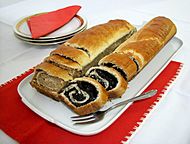
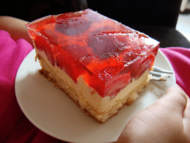
- Beza - A sweet meringue biscuit, sometimes with a topping.
- Makowiec - Sweet poppy-seed swiss roll, with raisins, dried fruits, and walnuts.
- Pączek - Round doughnuts filled with rose petal jam, other fruit jams, custard, chocolate, or quark with sugar.
- Pierniki - Soft gingerbread biscuits, either plain or filled with fruit marmalade and sometimes covered with chocolate.
- Sernik - Sernik (cheesecake) is one of the most popular desserts in Poland. It's a cake made mainly from twaróg, a type of fresh cheese like quark. It can be baked or chilled. It might be flavored with vanilla, lemon peel, or orange peel. Sometimes raisins or fresh fruits are added. It's also common to top it with chocolate or sprinkle it with coconut flakes or nuts. Unbaked sernik is often topped with sweet jelly and fresh fruits.
- Mazurek - A Pie baked especially for Christmas Eve and Easter. It's made with shortcrust pastry. There are different versions with fillings like walnut paste, dulce de leche, or ganache with dried fruits, candied fruit, and nuts.
- Chałka - Sweet white wheat bread of Jewish origin (Challah).
- Kogel mogel - eggnog made from egg yolks, sugar, and flavors like honey, vanilla, or cocoa. It's traditional for Polish Jews.
- Krówki - Polish fudge, soft milk toffee candies.
- Napoleonka - A Polish type of cream pie made of two layers of puff pastry, filled with vanilla pastry cream. It's usually sprinkled with powdered sugar. It's similar to the French millefeuille. Another less popular name is kremówka, often with whipped cream instead of custard.
- Keks - Cake with candied and dried fruit.
- Babka - The Polish version of a pound cake, made with or without yeast. It's served with powdered sugar or icing. It can also be made as a marble cake.
- Miodownik - Layered honey cake filled with vanilla pastry cream and ganache on top.
- Orzechowiec - Layered nut cake filled with vanilla pastry cream and kajmak with chopped nuts on top.
- Ciasto marchewkowe - Carrot cake with added nuts and honey, sometimes layered with whipped cream.
- Ciasto bez pieczenia/na zimno - Various types of unbaked and chilled cakes made with biscuits, ladyfingers, crackers, or sponge cake. They have vanilla, whipped cream, coconut, jelly, mascarpone, semolina, or poppy seed filling, often with ganache on top.
- Karpatka - Cream pie made of two layers of choux pastry filled with vanilla pastry cream.
- Wuzetka - Layered chocolate sponge cake filled with jam and whipped cream, linked to Warsaw.
- Ptasie mleczko - Chocolate-covered candy filled with soft meringue (or milk soufflé).
- Kisiel - Clear, jelly-like sweet fruit liquid, made with starch, sugar, and fruits or fruit juice.
- Budyń - Pudding, usually comes in many different flavors, such as sweet cream, vanilla, chocolate, cherry, etc.
- Faworki - Light fried pastry covered with powdered sugar.
- Pańska Skórka, Miodek - A kind of hard Taffy sold at cemeteries during Zaduszki and in the Old Town (Stare Miasto) in Warsaw.
- Kutia - Grain dish made with wheat, poppy seeds, nuts, raisins, and honey. It's not traditionally Polish but is served during Christmas in the eastern regions (Białystok, Podlachia).
- Prince Polo - Polish chocolate bar.
- Mieszanka Wedlowska - Assorted chocolate-covered candy.
- Torcik Wedlowski - Large, round, chocolate-covered wafer with handmade decorations.
- Pawełek - Chocolate bar with a flavored filling, most popular contains advocaat.
- Śliwka w czekoladzie - Chocolate-covered prune.
- Ryż z jabłkami - A type of rice pudding baked or cooked with apples and cinnamon.
Drinks
Alcoholic Drinks
Traditional Polish alcoholic drinks include mead, beer, vodka (old Polish names: okowita, gorzała), and to a lesser extent, wine. In recent years, beer has become very common. Wine is drunk less often, but its popularity is growing. More local grape wines are being made in small vineyards in Lesser Poland, Subcarpathia, Silesia, and West Pomerania. Among alcoholic drinks, Polish vodka is traditionally made from grain or potatoes. It largely replaced the once common mead.
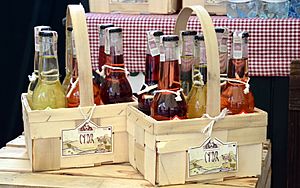
Some sources say that vodka was first made in Poland as early as the 8th century, becoming more common in the 11th century. The first time the drink and the word "vodka" were written down was in 1405. This was in Akta Grodzkie, court documents from the Palatinate of Sandomierz in Poland.
Large-scale vodka production began in Poland at the end of the 16th century. By the 17th and 18th centuries, Polish vodka was known in many countries, including the Netherlands, Denmark, England, Russia, and Germany. Vodka was the most popular alcoholic drink in Poland until 1998, when beer became more popular.
Besides clear vodkas, flavored vodka (called nalewka) and liqueurs are also popular. The most important are Żubrówka (vodka with bison grass from Podlasie), herbal Żołądkowa Gorzka, aged Starka, plum brandy śliwowica (especially from Łącko), honey liqueur Krupnik, and Goldwasser (herbal liqueur with gold flakes) and juniper vodka machandel, both from Gdańsk.
Non-Alcoholic Drinks
Traditionally, kwas chlebowy was a fermented drink that was first popular among farmers. Later, it spread to the nobles (szlachta) and became a common Polish drink by the 14th-15th centuries. It's usually made from rye bread, often called black bread. It's not considered an alcoholic drink in Poland, as its alcohol content is usually very low (0% to 2%). There are many store-bought and homemade versions of the drink, but traditional Polish recipes still exist. Even though it was made in large amounts in Poland between the world wars, it started to lose popularity to mass-produced soft drinks and carbonated water in the 20th century. It remained known mostly in rural areas of eastern Poland. However, kvass started to become popular again in the 21st century, with many new Polish brands appearing.
Today, tea is perhaps the most popular drink. It's sometimes drunk with a slice of lemon and sweetened with sugar. Tea came to Poland from England shortly after it appeared in Western Europe, mainly thanks to Dutch merchants. However, its widespread use is linked to the Russians in the 19th century. At that time, samovars imported from Russia became common in Polish homes. Tea is usually served with a slice of lemon and sweetened with sugar or honey. Tea with milk is called a bawarka ("Bavarian style").
Coffee has also been widely drunk since the 18th century, as Poland shared a border with the Ottoman Empire back then. Other commonly drunk beverages include: buttermilk, kefir, soured milk, instant coffee, various mineral waters, juices, and many brands of soft drink. Many Poles enjoy carbonated water, and restaurants always offer both still and sparkling (carbonated) water to drink.
See also
 In Spanish: Gastronomía de Polonia para niños
In Spanish: Gastronomía de Polonia para niños







